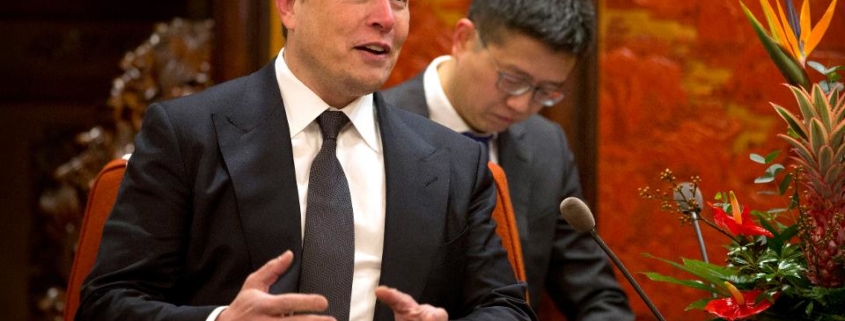Leading Like Jeff Bezos Or Elon Musk: Lessons From Their Contrasting Styles
Jeff Bezos, Amazon founder and CEO, speaking at The Economic Club of Washington’s Milestone Celebration. (AP Photo/Cliff Owen, File)
ASSOCIATED PRESS
Whatever your views of Jeff Bezos and Elon Musk, it’s hard to argue with their success at creating and leading innovative organizations with daring missions. Jeff Bezos leads Amazon and Blue Origin, the space company that wants to take you to the moon. Elon Musk leads Tesla and SpaceX, the space company that wants to take you to Mars to join a colony. Collectively the companies they lead have generated over $1 trillion in market value over the past 10 years. So it’s not surprising that Bezos and Musk are tied for the No. 1 spot in our 2019 Forbes ranking of America’s Most Innovative Leaders.
But when we interviewed them (and those that work with them), we found some interesting paradoxes when comparing their leadership styles. Of course, there are important similarities. For example, they have both successfully turned visions into reality by building and leveraging their Innovation Capital—their capacity to win resources and support to pursue radical new ideas (See Innovation Capital: How to Compete – and Win – Like the World’s Most Innovative Leaders, Harvard Business Review Press, June 2019). If nearly anyone other than Elon Musk had proposed drilling tunnels underneath Los Angeles, they would have been laughed out of the building. But when Musk proposed the “Hyperloop” he was greeted with enthusiasm, fanfare…and even investment. By just mentioning the idea for “Hyperloop” (an idea that has actually been around since the early 1900s), Musk was able to generate an explosion of media attention to the idea (see Figure 1.1).

Figure 1.1
JEFF DYER, NATHAN FURR, AND MIKE HENDRON
But beyond their innovation capital, these two leaders have led the way to these outsize outcomes in markedly different ways. Here’s how—and why—they both succeed with differing leadership styles.
Customer First vs. Technology First
Bezos is very much a “customer first” innovator. He has established an innovation process at Amazon called “working backwards” which takes as its starting point an obsessive focus on a customer’s needs and then works backward to figure out how to innovate to best meet those needs (see “How Does Amazon Stay at Day One?”). In essence, Bezos leverages an approach focused on resolving market (demand) uncertainty (uncertainty around customer preferences) and then assumes the technology uncertainty can be worked out.
In contrast, Musk uses what might be described as a technology-first approach. According to one former Telsa executive, “I think Elon has adopted the philosophy of Steve Jobs where he believes he knows where the market is going and knows better than customers know what they need and what they will want. As a result, he places relatively little stock in what they’re clamoring for at the moment and much more of it in the first principles solutions that they don’t even know they need yet.” Thus, Musk picks what he perceives as a big important problem that hasn’t been solved because of technology constraints. He attributes his problem solving success to first-principles thinking. “I operate on the physics approach of analysis by first principles,” Musk told us. The first-principles approach—which was first articulated and named by Aristotle—is the practice of identifying the fundamental key constraints to achieving a breakthrough in performance and then testing every option possible for eliminating one or more of those constraints. For example, with Tesla the key constraints to success were reducing the cost of the battery and getting battery range to exceed 300 miles. With SpaceX it was overcoming the constraints to creating reusable rockets that would dramatically lower the cost of space travel. With The Boring Company, the key constraint to success is the tunneling speed of a “boring” machine. Current machine tunneling speeds are three hundred feet per week. But according to Musk’s first-principles analysis, current machines are much slower than physics suggests they could be. So Musk wants to increase that speed to more than one mile per week, a tenfold improvement. Thus, he focuses on challenges where the need is clear, but the technology hasn’t been worked out.
Which one is better? Well that all depends what uncertainty you are trying to resolve. Bezos’ approach works especially well when the innovation requires a deep understanding of customer needs and preferences; or in other words when there is a lot of market (demand) uncertainty (will people buy it?). In contrast, Musk’s approach works well when there is a lot of technological uncertainty (can we build it?). This at least partly explains why Musk prefers trumpeting bold visions and goals whereas Bezos prefers to be more reserved in voicing visions and goals.
Voicing Visions and Goals
Musk and Bezos also differ dramatically in the way they voice, or communicate, visions and goals. Musk is very bold and public about voicing the lofty goals for his ventures. By contrast, Bezos is much more reserved. Is it simply personality, or something more?
One reason has to do with the types of problems they choose to solve. Bezos may be more tight-lipped because he’s explicitly taking into account the current needs of customers; consequently, he has no need to preemptively sell his innovations. He simply has to execute on it faster than competitors. So it’s in his best interest not to announce it before he’s launched the product. In contrast, Musk pursues breakthrough technologies; being bold and public is a way to attract attention and future customers. It also helps him attract financial resources and talented human capital (to solve those thorny technical problems).
But this difference also seems to be related to personal leadership style. When Musk launched SpaceX in 2002, he announced: “Our mission at SpaceX is to revolutionize space technology with the ultimate goal of enabling people to live on other planets.” He explicitly announced his goal of creating a human colony on Mars. He later even estimated that the cost for an individual to travel to the Mars colony would be “less than half a million dollars.” In stark contrast, Bezos quietly launched Blue Origin two years earlier in 2000 without bold public announcements. In fact, his first public interview about Blue Origin didn’t happen until 2005. Bezos prefers to test and learn quietly under the surface before revealing what he has discovered as a result of his innovation efforts.

Tesla CEO Elon Musk at a January, 2019 meeting with Chinese Premier Li Keqiang, not shown. (AP Photo/Mark Schiefelbein, Pool)
ASSOCIATED PRESS
Musk has been criticized for publicly broadcasting impossible stretch goals. Indeed, The Wall Street Journal reported that Tesla missed 20 of his broadcast goals, rarely hitting his ambitious timelines.[i] Musk has responded by saying that he doesn’t “set targets that I know can’t be met” and that “in order to have a good outcome, we must strive for a great outcome.” Tesla cofounder and chief technical officer J. B. Straubel believes in Musk’s approach, telling us, “Elon is a master at harnessing and channeling the team to do pretty amazing things that go beyond what the team even thought was possible. If you challenge people to work hard, they achieve more than they think they can. Most leaders don’t want to do that.” This doesn’t mean that Bezos doesn’t challenge his teams. In the executive team at Amazon, each leader has up to 20 serious stretch goals they commit to and deliver on. They are just less public in talking about them, in part, because they can internally fund their innovations, whereas Musk has to win much more external support to be able to create new industries.
A Deliberate Planning vs. Bold Leaps Approach
When Bezos launched Blue Origin, he wrote a “Day 1” letter, just as he did for Amazon. “We are a small team committed to seeding an enduring human presence in space,” he wrote. “Blue will pursue this long-term objective patiently, step by step. By dividing our work into small but meaningful increments, we hope to generate as many useful intermediate steps as possible. Each step, even our first and simplest, will be challenging. And each step will lay the technical and organizational foundation for the next.”
In contrast, Musk’s approach comes across as impatient and focused on major breakthroughs. When launching Tesla he wrote, “Our goal is to accelerate the advent of sustainable transport by bringing compelling mass market electric cars to market as soon as possible. . . . In order to get to get to that goal, big leaps in technology are required.” Bezos puts an emphasis on “step by step,” while Musk emphasizes “big leaps in technology.” Their differing styles have been characterized as being similar to the “tortoise (Bezos) and the hare (Musk).”[ii] Despite these differences in how they describe these goals, when it come to their actual day-to-day innovation processes, both lead a process focused on breaking down large problems into smaller, testable experiments.
Delegation and employee empowerment
Jeff Bezos is known at Amazon for being the last to speak at meetings. He prefers to listen to what others have to say without biasing them by giving his opinion first. Moreover, he is willing to let people run with an idea even if he disagrees with it. “Inside a large company you need to have multiple paths to ‘yes,’” he told us. “I’m a huge proponent of that. I often will ‘disagree and commit’ [an Amazon leadership principle where you are encouraged to disagree but then commit once a decision has been made] and I encourage other people to do this. I’ll say, ‘This idea doesn’t make sense to me. I’ll be totally honest about it. Here are my reasons.’ But I’ll say, ‘Look, you’re a high judgment person. Go try it.’ That’s what multiple paths to ‘yes’ means.” Bezos delegates and empowers employees to experiment and take risks. In fact, he once admitted, “I’ve made billions of dollars of failures at Amazon.com. Literally.”[iii]
In contrast, Musk pushes the agenda at Tesla and SpaceX forward at a frenetic pace. He believes in first-principles thinking, so if you want to convince him of something then show him through first-principles logic and analysis. But then again, if rockets don’t fly accurately or cars don’t drive correctly, people could die. So Musk monitors very closely, and will override a decision he thinks could be wrong. Musk’s hard charging approach results in challenging stretch goals for employees and a process for achieving them that involves intense monitoring on his part. This may partly explain why Bezos has had much more stability in his leadership team than Musk.
Conclusion: Lessons for Finding Your Path Forward
So what can be learned from these stark differences in leadership style when it comes to leading innovation? Bezos leads by small, incremental, proof-driven steps toward outcomes that win him the credibility to continually do new things. Recall that he didn’t start with this credibility—he had to win it over time, first by succeeding in selling books online. From that beachhead he has successfully expanded into online retailing, web services (with Amazon Web Services), electronic devices (e.g., Kindle, Alexa), and entertainment (Amazon Video and Amazon Music Unlimited). Bezos’s approach has been to build his reputation for innovation slowly, proof-by-proof over time through experiments that have resulted in solid, data-driven performance.
By contrast, Musk has taken what might be seen as a high risk/high reward approach of engaging in visionary thinking to win support for his bold ideas. He articulates a lofty and exciting vision for his ventures. This might seem like an easy thing to do with the lofty visions for SpaceX and Tesla; but he does it with even more mundane products like the Tesla PowerWall, which is essentially a big battery housed in your garage. About Powerwall he said, “We are trying to change the fundamental energy structure of the world.” He uses the approach of stating a grand vision to attract both human and financial resources to his ventures. “Elon really understands people,” says Sterling Anderson, former head of Tesla autopilot and co-founder of Aurora. “He understands that a lofty, inspirational vision attracts world-class people, particularly world-class engineers. With those engineers he’s able to build a better product. That product attracts customers and attracts investors, which reinforces the cycle.” After making his bold visions public, Musk then attracts both human and financial capital to his ventures and makes that vision attainable through a first-principles approach.
While following different paths, both Bezos and Musk have successfully launched multiple innovations and have risen to the top of our Most Innovative Leaders list. Their success through contrasting styles shows that innovative leadership does not rely on a predictable formula. But then, if it did, anybody could do it.












